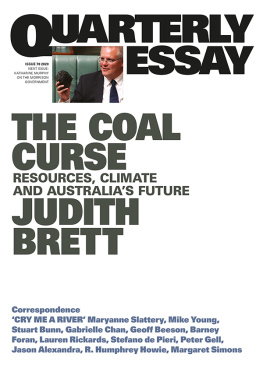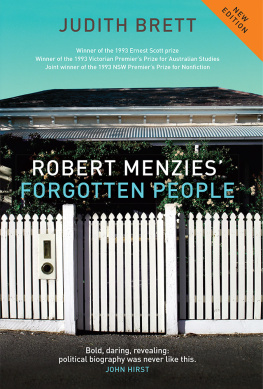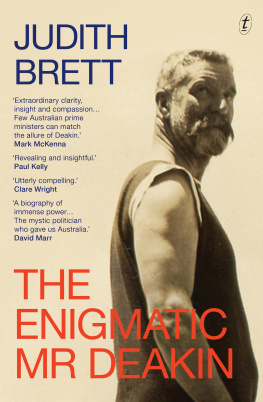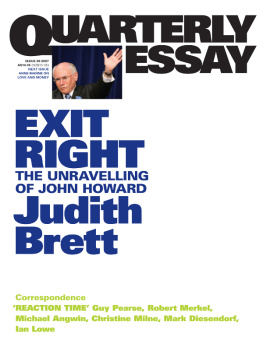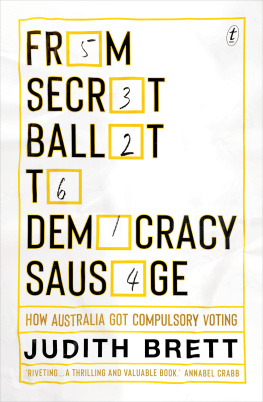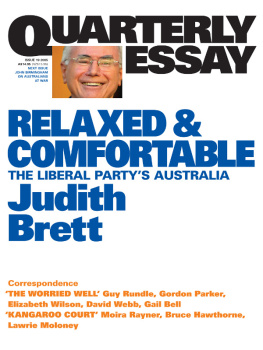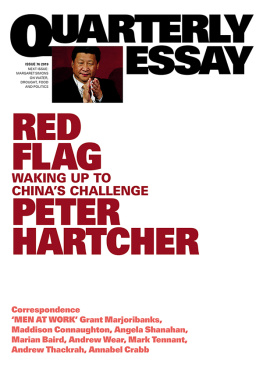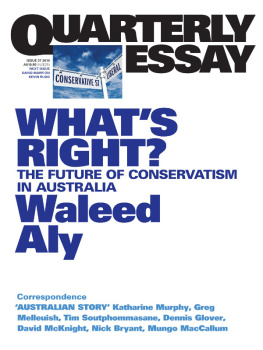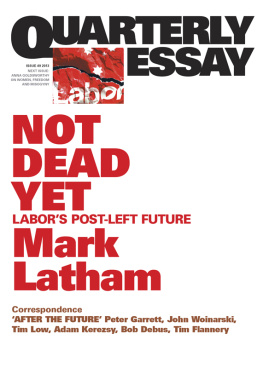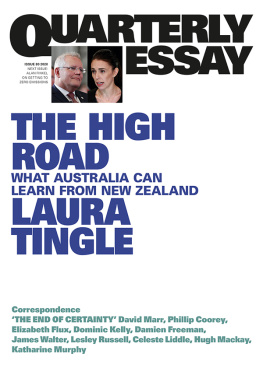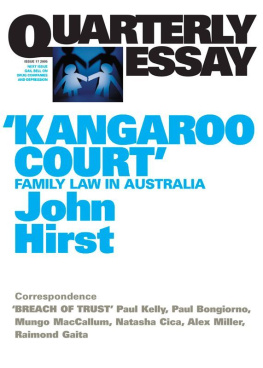Quarterly Essay is published four times a year by Black Inc., an imprint of Schwartz Books Pty Ltd. Publisher: Morry Schwartz.
ISBN 9781743821367 ISSN 1832-0953
All Rights Reserved.
No part of this publication may be reproduced, stored in a retrieval system, or transmitted in any form by any means electronic, mechanical, photocopying, recording or otherwise without the prior consent of the publishers.
Essay & correspondence retained by the authors.
Subscriptions 1 year print & digital (4 issues): $79.95 within Australia incl. GST. Outside Australia $119.95. 2 years print & digital (8 issues): $149.95 within Australia incl. GST. 1 year digital only: $49.95.
Payment may be made by Mastercard or Visa, or by cheque made out to Schwartz Books. Payment includes postage and handling.
To subscribe, fill out and post the subscription card or form inside this issue, or subscribe online:
quarterlyessay.com
Phone: 61 3 9486 0288
Correspondence should be addressed to:
The Editor, Quarterly Essay
Level 1, 221 Drummond Street
Carlton VIC 3053 Australia
Phone: 61 3 9486 0288 / Fax: 61 3 9011 6106
Email:
Editor: Chris Feik. Management: Elisabeth Young.
Publicity: Anna Lensky. Design: Guy Mirabella.
Assistant Editor: Kirstie Innes-Will. Production
Coordinator: Marilyn de Castro. Typesetting: Marilyn de Castro.
THE COAL CURSE | Resources, climate and Australias future |
Judith Brett |
I began writing this essay shortly after Christmas 2019, when south-east Australia was burning and the impacts of climate change were uppermost in everyones mind. I am finishing it in coronavirus lockdown in May 2020, as we obsessively follow infection and death rates, read endless articles about what to do at home with the kids, worry about the economic mayhem. Its hard to think about anything else. So let me take you back to early January, when the fire fronts were roaring through south-eastern Australia.
On the days around New Year, 4000 people were trapped on the beach at Mallacoota, waiting for the navy to bring in supplies and start an evacuation, car convoys were leaving Batemans Bay and the other holiday towns on the NSW south coast, Corryong was evacuating to Tallangatta and fire authorities were warning of worse to come. In his press conference the day after New Year, Prime Minister Scott Morrison batted away any suggestion that the catastrophic fires might push the Coalition to go harder on reducing emissions from fossil fuels, with arguments that were all too familiar:
Our emissions reduction policies will both protect our environment and seek to reduce the risks and hazards we are seeing today. At the same time it will seek to ensure the viability of peoples jobs and livelihoods all around the country. What we will do is ensure that our policies remain sensible, that they dont move towards either extreme, and stay focused on what Australians need for a vibrant and viable economy, as well as a vibrant and sustainable environment. Getting the balance right is what Australia, I think, has always been able to achieve.
Everything about Morrisons initial response to the fires was wrong, beginning with his ill-considered family holiday in Hawaii, flying off when the fires were already raging and the smoke was so thick in Sydney that tourists couldnt see the Bridge from the Opera House. Morrison was determined to see the fires as part of the expected pattern of Australian summers, and their management as the responsibility of the states emergency services. After mounting popular outrage forced him to cut his holiday short, he badly misread the reasons for peoples anger. He thought his absence had made Australians anxious, as if he were a monarch whose very presence reassured and gave comfort.
It was soon clear his presence was just as likely to arouse anger, and that meet-and-greets with fire victims could not be relied on to provide soothing photo opportunities. Visiting the fire-ravaged village of Cobargo in the Bega Valley, he was heckled, two people refused to shake his hand, and it was filmed for the whole nation to see. What people wanted was not a hug from Scotty, but leadership and decisive action from their prime minister: to pay the volunteer fire-fighters, to make sure they were properly equipped, to provide national leadership and coordination in an emergency that ignored state borders. And they wanted him to talk about climate change, to admit that the ferocity and extent of these fires were what scientists had been predicting as the climate warmed.
Greg Mullins, the former NSW Fire and Rescue Commissioner, described the fires as unprecedented. In December, he and twenty-eight other former fire and emergency chiefs had called for the prime minister to convene an emergency summit on how the country should prepare for bushfires in a changed climate. Back in April, they had tried to warn Morrison that fire behaviour was changing in Australia, and that a ramped-up and better-coordinated response and more resources were needed. They made a number of practical suggestions, but, said Mullins, We werent listened to.
As prime minister, Morrison does not deny that the climate is changing, nor that the burning of fossil fuels is the primary cause. This, it must be said, is a major advance on Tony Abbotts position, which was barely disguised denialism. But Morrison will not admit to the severity of the crisis, nor that his government is failing to respond to its seriousness. In his carefully calibrated statement on 2 January, he balanced two things: cutting emissions and protecting livelihoods all around the country. Not everyone lived in these fire-prone areas, he was reminding us, some lived in mining regions, and they had interests too, which the government must look after. Here it was again: economy versus environment, and the misleading search for balance between two supposedly competing goods.
As the fires burned, I was in no mood for balance. I was angry. Scientists had been warning of fires like these for decades. Ross Garnaut had predicted fires of this scale in 2008 in the Climate Change Review he authored for state, territory and federal governments. Former fire chiefs had warned of them not twelve months ago, as a persistent drought dried the bush. The government had responded with Dorothea McKellars land of drought and flooding rains to claim that fires were business-as-usual for the Australian bush and with a childlike theory of causation where the only cause of a fire is the spark that sets it off, whether it be the arsonists match, the unattended camp fire or a lightning bolt. Of course rising temperatures do not produce the spark, but they do create the conditions to make the fires more intense and destructive. Rainforest was burning that had never burned before, as it had in Tasmania in the first months of 2016.
Over New Year, my favourite place on earth was burned: the campgrounds at Thurra River and Mueller Inlet near the Point Hicks Lighthouse in East Gippsland. I had camped there with family and friends for the past twenty years, and we were booked to camp there again in February. It was beautiful: magnificent old mahogany gums with snaking trunks and limbs, a short tannin-bronzed river and estuary, long white beaches and sheltered bays, enormous sand dunes which took you to the top of the world. For a few weeks a year it was all ours, as so many annual holiday spots on the south and east coasts are to others.
I know that the loss of a loved camping ground is not in the same league as burned houses, sheds and livestock, or a loved friend or family member killed fighting the fire. We werent there and we didnt face the horror of the walls of flame. Our comfortable city-based lives went on almost as usual. But awake at night I had losses to mourn: the habitat destruction, and the reptiles, birds and animals that had been killed the stately lace monitors, the lyrebirds and red-bellied black snakes, the bright blue dragonflies. Maybe it will all bounce back; but maybe it wont. Maybe it will be burned again before the plants and animals have the chance to recover. It is not just the intensity of the fires that is new, but their increased frequency, and both will get worse as the planet heats.

